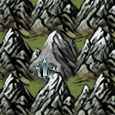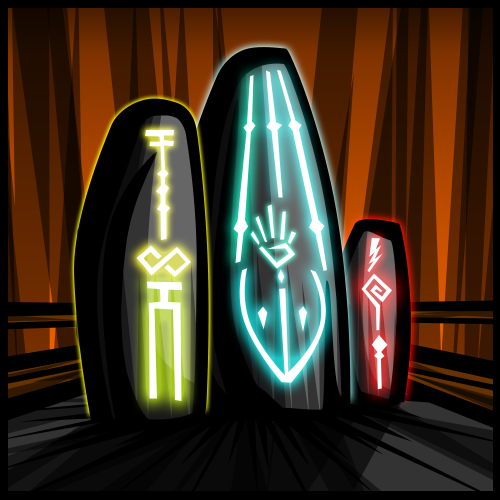 Our last blog piece happened to mention Obsidian Mines. Obsidian Mines are unusual and I’ll get to explaining them in a minute. But first, let’s start with something easy, Silverthorn.
Our last blog piece happened to mention Obsidian Mines. Obsidian Mines are unusual and I’ll get to explaining them in a minute. But first, let’s start with something easy, Silverthorn.
So, lets imagine that after harvesting is in the game, you log on to find a herb patch next to your settlement. (There will be herb patches all over the map. Lets assume you are lucky enough to have one on your doorstep.) You send scouts out to see what it is, and they report that it’s Silverthorn.
You build a Herbalist’s building, and recruit appropriate gatherer units. You send the units to the patch, and if they aren’t interrupted by someone else’s units, after a while they come back with the herbs for you. In terms of game mechanics, that’s pretty simple. It’s like sending out caravans to gather from the map, except you’re sending Herbalists, not Caravans.
 But what do you do with your Silverthorn? This is not a herb you will need every day. It isn’t used for weapon making, and you probably only want to use one piece every couple of months, at least in times of peace. There are 80-90 patches of Silverthorn on the map, each potentially yielding two dozen pieces of Silverthorn herb each day. So what do you do?
But what do you do with your Silverthorn? This is not a herb you will need every day. It isn’t used for weapon making, and you probably only want to use one piece every couple of months, at least in times of peace. There are 80-90 patches of Silverthorn on the map, each potentially yielding two dozen pieces of Silverthorn herb each day. So what do you do?
You could share the patch with all your neighbours, and let anyone harvest when they wish.
Or you could put an army on the patch, reserving your spot and farming more of the herb every day: you might want to sell the herb on the market, or you might become your Alliance’s supplier. 80-90 patches sounds like a lot, but it’s still less than one patch per active Alliance in the game, and every Alliance is likely to want a supply.
And of course, you could destroy it, or an enemy could. It’s a herb patch – a growing thing – so if you just take some, it will grow back, but if you take every last piece of the herb then you have destroyed the patch.
The game mechanics are fairly simple, much like caravans. Where it gets complicated is that we hope to have nearly 30 herbs on the map by the end of the year, around half in the first gathering release.
So lots of people will have access to herbs that others need, and everyone will benefit from herbs that don’t happen to grow on their doorstep. The complexity is not in the mechanics. The complexity is in the questions it raises for the players. What do you do with a rare herb? Share it, sell it, give it away? What do you do if you would get an advantage from having a herb that isn’t available near you? Beg, buy, steal, or go without?
 And in addition, where animals are slain patches of Hides, including rare animals parts, will be left behind (as in this image). And there are also minerals. Which brings us back to Obsidian.
And in addition, where animals are slain patches of Hides, including rare animals parts, will be left behind (as in this image). And there are also minerals. Which brings us back to Obsidian.
Obsidian is a mineral, not a herb, so can’t be eradicated by over-farming. Its deposits are fixed on the map. There are not many deposits, and they are all in a fairly narrow geographical area. Its use is in weapon making: if you build a specialist Armourer or Weaponsmith (new buildings introduced with the harvesting release) and dedicate them solely to making, say, Obsidian Blades (swords) or Obsidian Platemail, then you could consume hudreds of pieces of Obsidian each day, which would require an Obsidian mine to be operated on an industrial scale. All of this makes it much more complicated than Silverthorn.
When gathering goes live, with the gatherer buildings and units, herbs and minerals and animal parts, and specialist weaponsmith and armourer buildings, it may look rather complicated.
But the result will be profound. Players will have different special resources available to them, and lots of choices in what to do with those resources.

 What equipment is ideal will also depend upon the exact mission, as well as a player’s strategy. For example, when sending your Dwarven Halbardiers to defend a neighbouring settlement from an unexpected attack, you may want them to carry lighter than usual equipment so that they can get to their destination as fast as possible, before the attack strikes.
What equipment is ideal will also depend upon the exact mission, as well as a player’s strategy. For example, when sending your Dwarven Halbardiers to defend a neighbouring settlement from an unexpected attack, you may want them to carry lighter than usual equipment so that they can get to their destination as fast as possible, before the attack strikes. If they are to defend a wooded tournament square, then perhaps you want them to carry only shorter spears and armour adapted for woodland combat, so that they get bonuses based on that terrain.
If they are to defend a wooded tournament square, then perhaps you want them to carry only shorter spears and armour adapted for woodland combat, so that they get bonuses based on that terrain. If you want the same units to defend a nearby Obsidian Mine, then you may want really heavy armour that gives a bonus in defence and Pikes to fend of cavalry raiders, and as the troops won’t move often you won’t much care how much this bulky equipment slows their movement. And so on.
If you want the same units to defend a nearby Obsidian Mine, then you may want really heavy armour that gives a bonus in defence and Pikes to fend of cavalry raiders, and as the troops won’t move often you won’t much care how much this bulky equipment slows their movement. And so on.



 Old style game development (like boxed console games) can be a struggle to keep control. Any unexpected behaviour is a bug. Any part of the game that the developer doesn’t architect, is a source for alarm.
Old style game development (like boxed console games) can be a struggle to keep control. Any unexpected behaviour is a bug. Any part of the game that the developer doesn’t architect, is a source for alarm.








 .
.